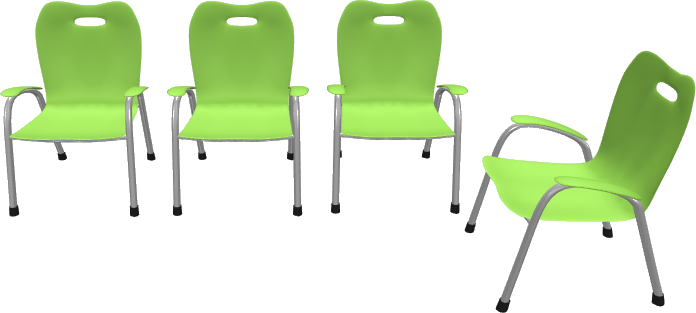Chair Power: explore types of power
 This exercise gives participants a chance to explore different types of power. To begin, set up a number of chairs in a configuration (such as in the image) and then ask the participants "Which chair is the most powerful?".
This exercise gives participants a chance to explore different types of power. To begin, set up a number of chairs in a configuration (such as in the image) and then ask the participants "Which chair is the most powerful?".
Get input from the participants why they think a particular chair is the most powerful. While you are facilitating, keep in mind:
- There are no rights-or-wrongs
- Encourage diversity ("how about this chair? Why is this chair the most powerful?")
- Encourage and note difference ("so you think this chair is powerful because of THIS? Disagreements?").
- Use brief follow-up questions: "So why is this one powerful?"
- Gets lot of different input from different people
- Try to keep noting themes in the conversation, disagreements (use the three types of power [below] as a mental hook): e.g. "So there are a range of different types of power here." "So one type of power seems to be what people are calling X and another is Y."
To help participants go deeper here are some ways to keep pushing:
- Ask participants to move one chair in such a way as to make it the most powerful or exaggerate its power (you may reset chairs at various points);
- Ask participants to sit in a chair in such a way as to make it the most powerful chair (get four volunteers at a time). Ask them to freeze once they find their position and have the outside observers note what they see ("How did they try to make it powerful?" "What kinds of power do you see here?")
After getting a wide range of options and conversation, introduce the three types of power.
Power over: this is often the initial understanding of power. It is the ability to get someone to do something, no matter if they want to do it or now.
Power-with: the power to act collectively with others. The power that comes from community, solidarity, cooperation.
Power-within: is power on the individual level. It means on one hand to realise one’s own situation of adjusting, dependency and oppression, to want to free oneself from this; on the other hand it means to realise that every person him/herself has the possibility, to influence the course of her/his own life and to change it.
Training for Change: Chair Power: three types of power
